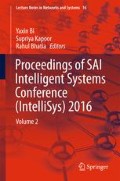Abstract
An Embodied Conversational Agent-based human deception detection system was tested in a laboratory experiment during which some subjects had committed a mock crime and had guilty knowledge of that crime. Sensor signals were analyzed for their ability to discriminate between guilty/deceptive and innocent/truthful examinees and suitability for conducting automated agent-based deception interviews. Electrodermal activity confirmed the presence of arousal during the agent-based interviews.
This research was supported by the U.S. Department of Homeland (DHS) Security and the Center for Identification Technology Research (CITeR), a National Science Foundation I/UCRC.
Access this chapter
Tax calculation will be finalised at checkout
Purchases are for personal use only
References
Derrick, D.C., Elkins, A.C., Burgoon, J.K., Nunamaker Jr., J.F., Zeng, D.: Border security credibility assessments via heterogeneous sensor fusion. IEEE Intell. Syst. 25(3), 41–49 (2010)
Nunamaker Jr., J.F., Derrick, D.C., Elkins, A.C., Burgoon, J.K., Patton, M.W.: Embodied conversational agent-based kiosk for automated interviewing. J. Manag. Inf. Syst. 28(1), 17–48 (2011)
Twyman, N.W., Lowry, P.B., Burgoon, J.K., Nunamaker Jr., J.F.: Autonomous scientifically controlled screening systems for detecting information purposely concealed by individuals. J. Manag. Inf. Syst. 31(3), 106–137 (2014)
Derrick, D.C., Jenkins, J.L., Nunamaker Jr., J.F.: Design principles for special purpose, embodied, conversational intelligence with environmental sensors (SPECIES). AIS Trans. Hum.-Comput. Interact. 3(2), 62–81 (2011)
Sokolov, E.N.: Higher nervous functions: orienting reflex. Annu. Rev. Physiol. 25(1), 545–580 (1963)
Posner, M.I.: Orienting of attention. Q. J. Exp. Psychol. 32(1), 3–25 (1980)
Cannon, W.B.: Bodily changes in pain, hunger, fear and rage: An account of recent research into the function of emotional excitement. Appleton-Century-Crofts, New York (1929)
Gardner, R.M., Beltramo, J.S., Krinsky, R.: Pupillary changes during encoding, storing, and retrieval of information. Percept. Mot. Skills 41(3), 951–955 (1975)
Goldwater, B.C.: Psychological significance of pupillary movements. Psychol. Bull. 77(5), 340–355 (1972)
Nieuwenhuis, S., De Geus, E.J., Aston-Jones, G.: The anatomical and functional relationship between the P3 and autonomic components of the orienting response. Psychophysiology 48(2), 162–175 (2011)
Nunnally, J.C., Knott, P.D., Duchowski, A.: Pupillary response as a general measure of activation. Atten. Percept. Psychophys. 2(4), 149–155 (1967)
Bradley, M.T., Janisse, M.P.: Accuracy demonstrations, threat, and the detection of deception: cardiovascular, electrodermal, and pupillary measures. Psychophysiology 18(3), 307–315 (1981)
Janisse, M.P., Bradley, M.T.: Deception, information and the pupillary response. Percept. Mot. Skills 50(3), 748–750 (1980)
Lubow, R.E., Fein, O.: Pupillary size in response to a visual guilty knowledge test: new technique for the detection of deception. J. Exp. Psychol. Appl. 2(2), 164–177 (1996)
Apple, W., Streeter, L.A., Krauss, R.M.: Effects of pitch and speech rate on personal attributions. J. Pers. Soc. Psychol. 37(5), 715–727 (1979)
Bachorowski, J.A., Owren, M.J.: Vocal expression of emotion: Acoustic properties of speech are associated with emotional intensity and context. Psychol. Sci. 6(4), 219–224 (1995)
DePaulo, B.M., Lindsay, J.J., Malone, B.E., Muhlenbruck, L., Charlton, K., Cooper, H.: Cues to deception. Psychol. Bull. 129(1), 74–118 (2003)
Elkins, A.C., Stone, J.: The Effect of Cognitive Dissonance on Argument Language and Vocalics. Kauai, Koloa (2011)
Rockwell, P., Buller, D.B., Burgoon, J.K.: Measurement of deceptive voices: Comparing acoustic and perceptual data. Appl. Psycholinguist. 18(4), 471–484 (1997)
Zuckerman, M., DePaulo, B.M., Rosenthal, R.: Verbal and nonverbal communication of deception. In: Berkowitz, L. (ed.) Advances in Experimental Social Psychology, vol. 14, pp. 1–59. Academic Press, New York (1981)
Buller, D.B., Burgoon, J.K.: Interpersonal deception theory. Commun. Theory 6(3), 203–242 (1996)
Elkins, A.C., Derrick, D.C., Gariup, M.: The voice and eye gaze behavior of an imposter: automated interviewing and detection for rapid screening at the border. In: Conference of the European Chapter of the Association for Computational Linguistics, Avignon, France (2012)
Gamer, M., Rill, H.G., Vossel, G., Gödert, H.W.: Psychophysiological and vocal measures in the detection of guilty knowledge. Int. J. Psychophysiol. 60(1), 76–87 (2006)
Lykken, D.T.: The GSR in the detection of guilt. J. Appl. Psychol. 43, 385–388 (1959)
Krapohl, D.J., McCloughlan, J.B., Senter, S.M.: How to use the concealed information test. Polygraph 35(3), 34–49 (2009)
Cronbach, L.J.: Coefficient alpha and the internal structure of tests. Psychometrika 16(3), 297–334 (1951)
Rosenthal, R.: Handbook of Methods in Nonverbal Behavior. In: Ekman, P., Scherer, K. (eds.), Cambridge, New York (1982)
Nunnally, J.C.: Psychometric Theory. McGraw-Hill, New York (1978)
Mossman, D., Somoza, E.: ROC curves, test accuracy, and the description of diagnostic tests. J. Neuropsychiatry Clin. Neurosci. 3, 330–333 (1991)
Somoza, E., Mossman, D.: Neuropsychiatric decision making: Designing nonbinary diagnostic tests. J. Neuropsychiatry 3, 197–200 (1991)
Burgoon, J.K., Floyd, K.: Testing for the motivation impairment effect during deceptive and truthful interaction. West. J. Commun. 64(3), 243–267 (2000)
Author information
Authors and Affiliations
Corresponding author
Editor information
Editors and Affiliations
Rights and permissions
Copyright information
© 2018 Springer International Publishing AG
About this paper
Cite this paper
Elkins, A.C., Proudfoot, J.G., Twyman, N., Burgoon, J.K., Nunamaker, J.F. (2018). Embodied Conversational Agent-Based Deception Detection. In: Bi, Y., Kapoor, S., Bhatia, R. (eds) Proceedings of SAI Intelligent Systems Conference (IntelliSys) 2016. IntelliSys 2016. Lecture Notes in Networks and Systems, vol 16. Springer, Cham. https://doi.org/10.1007/978-3-319-56991-8_22
Download citation
DOI: https://doi.org/10.1007/978-3-319-56991-8_22
Published:
Publisher Name: Springer, Cham
Print ISBN: 978-3-319-56990-1
Online ISBN: 978-3-319-56991-8
eBook Packages: EngineeringEngineering (R0)

